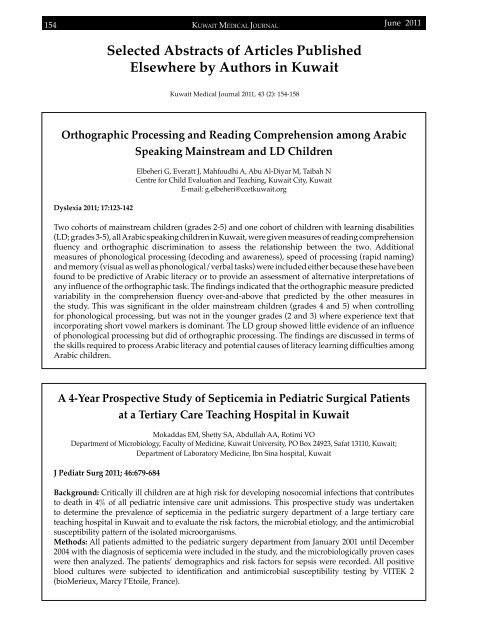Vol 43 # 2 June 2011 - Kma.org.kw
Vol 43 # 2 June 2011 - Kma.org.kw
Vol 43 # 2 June 2011 - Kma.org.kw
Create successful ePaper yourself
Turn your PDF publications into a flip-book with our unique Google optimized e-Paper software.
154<br />
KUWAIT MEDICAL JOURNAL<br />
<strong>June</strong> <strong>2011</strong><br />
Selected Abstracts of Articles Published<br />
Elsewhere by Authors in Kuwait<br />
Kuwait Medical Journal <strong>2011</strong>, <strong>43</strong> (2): 154-158<br />
Orthographic Processing and Reading Comprehension among Arabic<br />
Speaking Mainstream and LD Children<br />
Dyslexia <strong>2011</strong>; 17:123-142<br />
Elbeheri G, Everatt J, Mahfoudhi A, Abu Al-Diyar M, Taibah N<br />
Centre for Child Evaluation and Teaching, Kuwait City, Kuwait<br />
E-mail: g.elbeheri@ccetkuwait.<strong>org</strong><br />
Two cohorts of mainstream children (grades 2-5) and one cohort of children with learning disabilities<br />
(LD; grades 3-5), all Arabic speaking children in Kuwait, were given measures of reading comprehension<br />
fluency and orthographic discrimination to assess the relationship between the two. Additional<br />
measures of phonological processing (decoding and awareness), speed of processing (rapid naming)<br />
and memory (visual as well as phonological/verbal tasks) were included either because these have been<br />
found to be predictive of Arabic literacy or to provide an assessment of alternative interpretations of<br />
any influence of the orthographic task. The findings indicated that the orthographic measure predicted<br />
variability in the comprehension fluency over-and-above that predicted by the other measures in<br />
the study. This was significant in the older mainstream children (grades 4 and 5) when controlling<br />
for phonological processing, but was not in the younger grades (2 and 3) where experience text that<br />
incorporating short vowel markers is dominant. The LD group showed little evidence of an influence<br />
of phonological processing but did of orthographic processing. The findings are discussed in terms of<br />
the skills required to process Arabic literacy and potential causes of literacy learning difficulties among<br />
Arabic children.<br />
A 4-Year Prospective Study of Septicemia in Pediatric Surgical Patients<br />
at a Tertiary Care Teaching Hospital in Kuwait<br />
Mokaddas EM, Shetty SA, Abdullah AA, Rotimi VO<br />
Department of Microbiology, Faculty of Medicine, Kuwait University, PO Box 24923, Safat 13110, Kuwait;<br />
Department of Laboratory Medicine, Ibn Sina hospital, Kuwait<br />
J Pediatr Surg <strong>2011</strong>; 46:679-684<br />
Background: Critically ill children are at high risk for developing nosocomial infections that contributes<br />
to death in 4% of all pediatric intensive care unit admissions. This prospective study was undertaken<br />
to determine the prevalence of septicemia in the pediatric surgery department of a large tertiary care<br />
teaching hospital in Kuwait and to evaluate the risk factors, the microbial etiology, and the antimicrobial<br />
susceptibility pattern of the isolated micro<strong>org</strong>anisms.<br />
Methods: All patients admitted to the pediatric surgery department from January 2001 until December<br />
2004 with the diagnosis of septicemia were included in the study, and the microbiologically proven cases<br />
were then analyzed. The patients’ demographics and risk factors for sepsis were recorded. All positive<br />
blood cultures were subjected to identification and antimicrobial susceptibility testing by VITEK 2<br />
(bioMerieux, Marcy l’Etoile, France).
















